Lurking underground . . . in an exceptionally crafted lair. The ingenious trap door is so perfectly camouflaged as to be indistinguishable from surrounding turf. An inch within the cavern, as daylight sparkles through the cracks, his eyes appear lanterns burning with unholy oil. Careful not to make a single sound, barely breathing, waiting. Further back in the tunnel are corpses wrapped and compressed, as though they’ve been put though a micro bailing machine—an extended mausoleum where Dracula’s silky evil serves as coffins for an assortment of insects. Suddenly, a cricket brushes the silken trip wire, setting off a terrible chain reaction. It’s over in a flash. The ground explodes in a fury of limbs and antennae, the hunter strikes from his burrow, impaling with fangs and efficiently whisking the prize underground. It was an effortless kill—the tarantula easily five times the heft of his quarry!
Okay, that’s a pretty gothic description. Is the tarantula a monster? Is it guilty of murder? There is no guilt or virtue in natural systems, only success or failure. When it comes to hunting, tarantulas are especially successful.
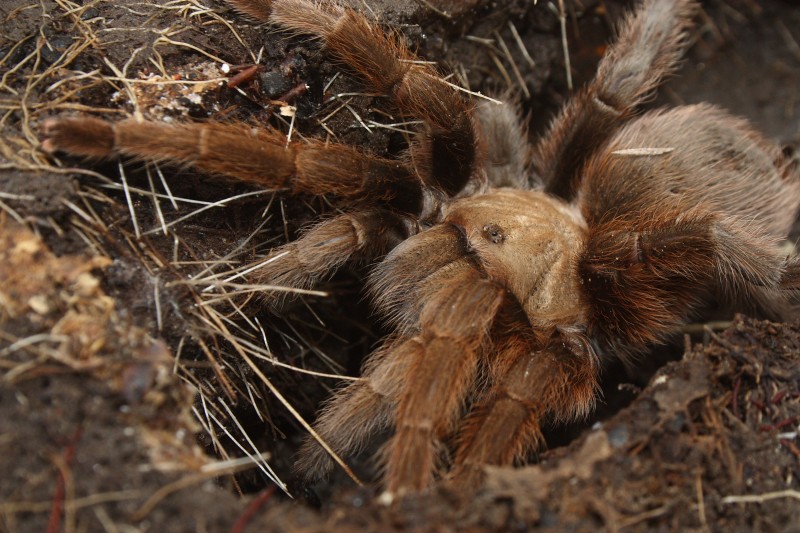
In Her Burrow
But did you ever wonder what it’s like to be the tarantula? Hiding in a dark hole most of the time? Who wants to risk going outside? Despite a full tummy and well-stocked pantry, how do you think it feels to know you routinely frighten most of the people on earth? To accept as people’s stereotypical first response that look of horror, followed by a spastic arachnophobic fit? Then they frantically search for something to smash you with . . . I mean, hell . . . it can’t be easy being a tarantula!
Fact is, tarantulas get a lot of bad press, regardless of doing good in this world. Because of their relative size and “hairy-ness,” the media tend to paint tarantulas as the bad guys. And let’s face it, most parents teach their kids to freak out at the first sight of spiders—not to mention tarantulas—because that’s how their parents raised them. No, it’s not easy to make friends with a tarantula, but, fortunately, it does happen.
Take, for example, one Judy Santerre. Judy is a trained naturalist living in Wimberley, Texas, and she’s friendly towards tarantulas in the wild. Problem was, Judy never had her phone with her when opportunities presented themselves. On her way to the mailbox one recent sunny day, Judy spotted a tarantula in the grass—let’s call her Helen. Luckily, Judy had her phone at the ready, bent down and snapped the photo.
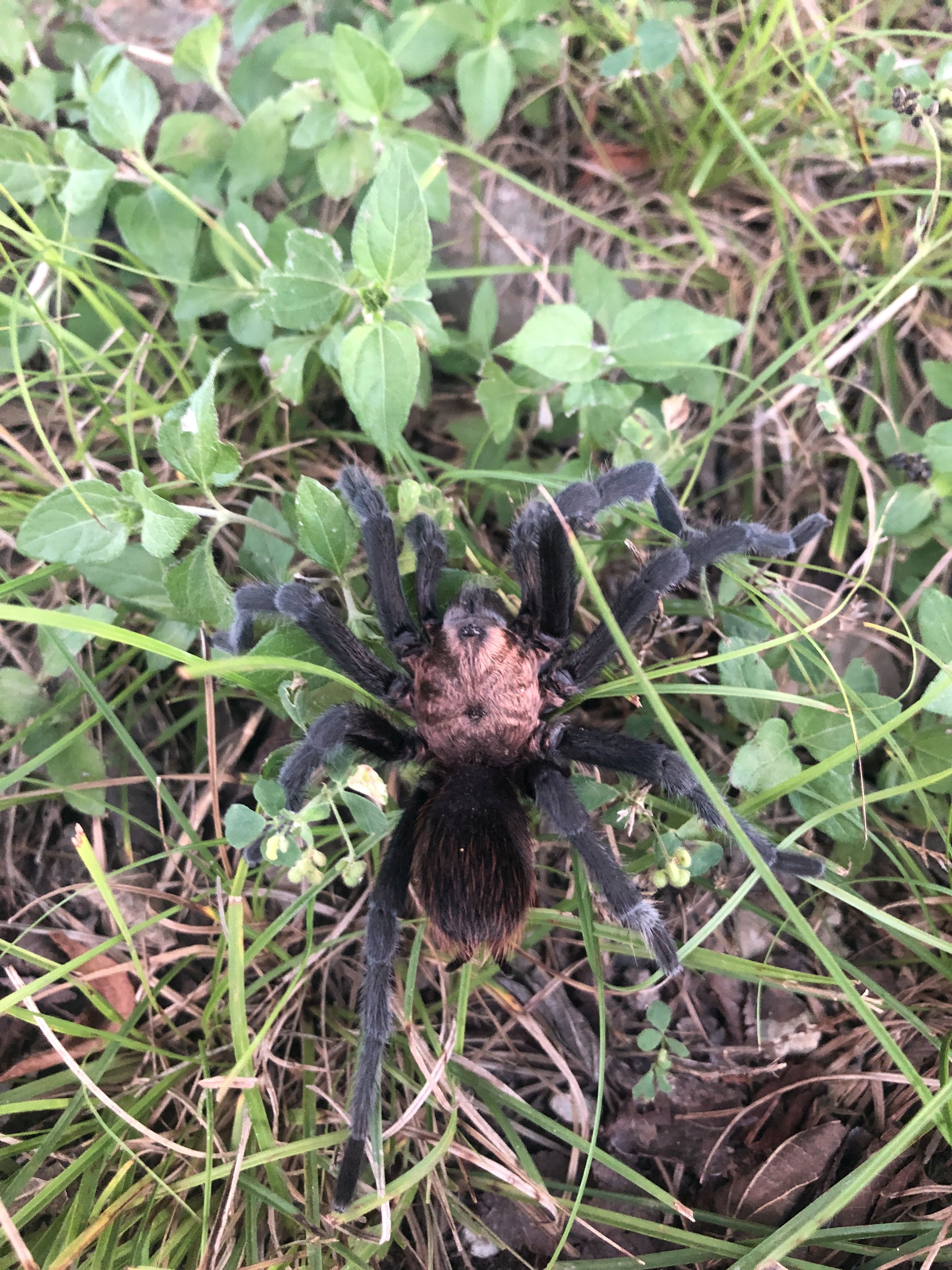
Meet Helen!
While most people would have run the other way upon seeing Helen, Judy was curious: “She was pretty lively. She darted across the road and hunkered by a tree – amazing. . . I really had no idea they were native to Texas. I thought somebody had gotten tired of a pet.” A pet, you say? Turns out, many folks keep tarantulas as terrarium-dwelling pets. Known as tarantulaphiles, they can range from curious kids to serious scientists (arachnologists). Many species of tarantula can be extremely placid and gentle and can make especially interesting pets. Tarantulas—like people—come in many different temperaments and personalities. Some are feisty and impossible to hold, others are gentle and would never think of biting. Some are skittish and fast, others completely chilled out and very slow moving. There are hundreds of species of tarantulas in the world but only about 14 of them are found in Texas (Texas A&M University field guide). Rio Grande Valley, coastal plains/prairies, Pineywoods, Hill Country, Trans-Pecos—tarantulas are all over Texas!
Valley, coastal plains/prairies, Pineywoods, Hill Country, Trans-Pecos—tarantulas are all over Texas!
Helen was most likely a Texas brown tarantula. It’s the most common species found in the southern United States (https://www.youtube.com/watch?v=7VjgJG_DEBc). Females can grow up to 6 inches in length while males will be a little bit smaller. These guys are mostly harmless to humans but they do instill the fear of God in some people. How do we know it was ‘Helen’ that fateful day at the mailbox and not ‘George?’ It takes mature males, a microscope, proper literature and a lot of experience to know for sure. Females have been known to live up to 40 years; males rarely live over a year after mating—so we’re leaning on the law of large numbers to support our hypothesis that Helen was a female.
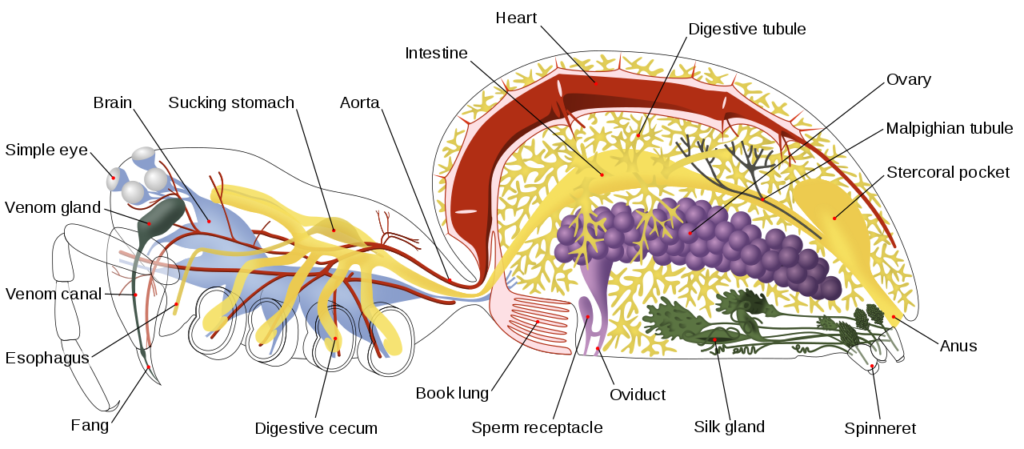
Generic Anatomy
As hunting machines, tarantulas are exceptionally equipped. While they can see and hear, their dominant sense is touch. They can sense the movements of prey, chemical signatures, vibrations and wind direction. When setting up a burrow, tarantulas line the inner core with silk and then lay strands of silk as “trip wires” outward to serve as early warning they can detect from inside. They also have massive powerful grasping limbs (chelicerae) tipped with long fangs. Their mouth is a short, straw-shaped opening that can only suck, meaning that anything taken into it must be in liquid form. Prey with large solid parts must be crushed and ground up or predigested, which is accomplished by coating the prey with digestive juices secreted from openings in the chelicerae.
Can they hurt humans? A Texas brown tarantula bite will hurt about like a bee sting does. It can cause similar allergic reaction for those susceptible to it but the venom is not life threatening. Due to the large size of their fangs, the puncture wound from a bite can lead to secondary infection issues if not properly treated. Another potential

Urticating Hairs Effect
problem can be caused by something called urticating hairs (from the top of the spider’s abdomen). Human eyes and skin can be irritated by these little hairs, which are rubbed off as a defensive measure by the tarantula’s hind legs when he is
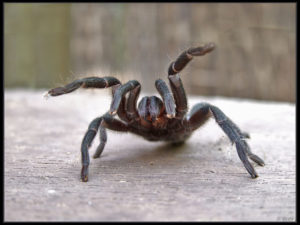
Defensive Posture (not a Texas Brown)
disturbed. Much like tiny needles on prickly pear cacti, these floating hairs can even be inhaled, inflaming nasal passages and lungs. To add bluster, when threatened, tarantulas will maneuver to face their attacker, raise up on their hind legs and stretch out their front claws in a threatening posture, as if to say ‘you want a piece of me, sucker?’
Tarantulas are active mostly between May and October. An odd (and not well understood) behavior of the Texas brown tarantula occurs at dawn and dusk in May through July and again in September through November. The countryside comes alive with male tarantulas on the roam. They sometimes wander across roads and highways in such numbers as to evoke that famous spider migration scene from the movie Harry Potter and the Chamber of Secrets. The pilgrimage has been known to gross out motorists on state highways and backcountry roads for years. Common belief is that this migration is a desperate search for love—but we don’t really know for sure.
One thing we do know, somehow the two sexes get together and make whoopee because each year the female tarantula will end up taking care of anywhere from 100 to 1,000 eggs. She keeps them in an underground burrow, wrapped in a hammock-like silk sack of her own design—which she protects with extreme ferocity. After from 45-60 days (usually in July) the spiderlings hatch within the egg sac. Once outside the egg sac, the youngin’s may stick with their mother for up to a week or so but then disperse to go find their fortunes. Sadly, many of these young spiders become lunch for other spiders or predators; hence, the large number of babies.
Tarantulas, like other spiders, have a hard exoskeleton with all their soft parts housed inside. In order to grow, molting of this hard outer shell is required. A young and growing tarantula may molt several times a year, whereas an adult can molt once a year or less. Molting is also required to grow or replace lost or damaged limbs or to replace lost urticating hairs. It’s a vulnerable time. The spider stops eating and lays on its back for several hours to shed the old exoskeleton. It takes several days for the new exoskeleton to harden. It’s during this in between time that growth occurs.
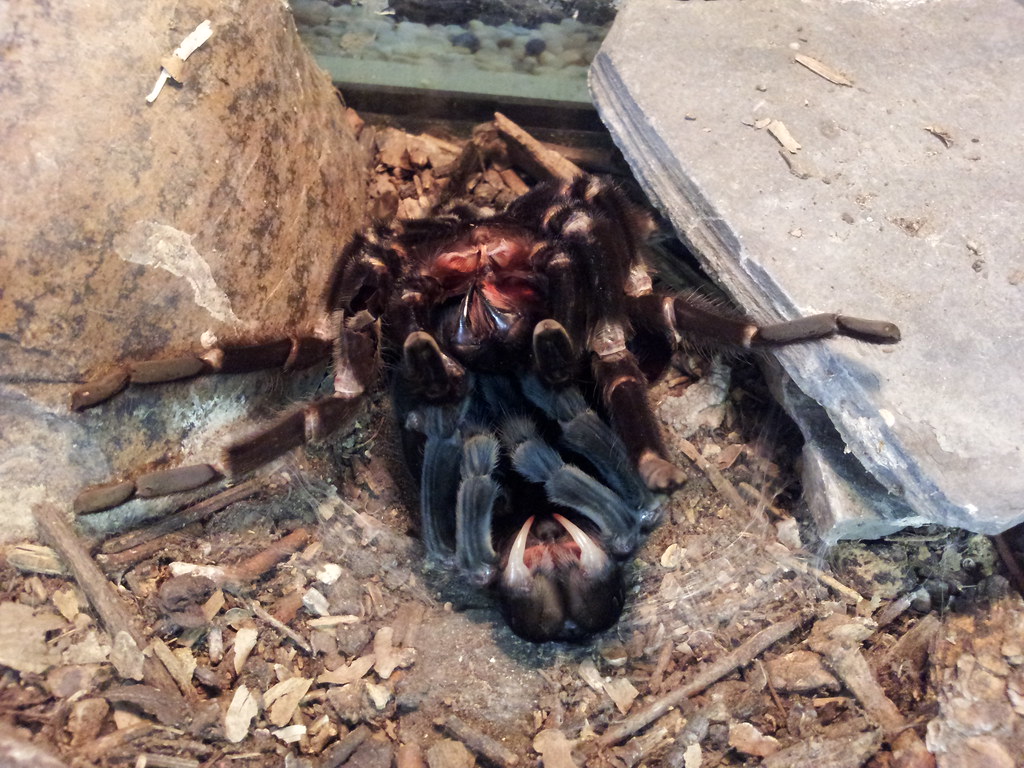
Texas Brown Molt (half-way)
There are other traits, however, which differentiate tarantulas from the majority of the spider world. Size is clearly one of them. Unlike other true spiders tarantulas don’t need to make elaborate webs to catch their prey. This puts them in a category (mygalomorphs) with only about 7 percent of the world’s spider species, along with the likes of purseweb and trapdoor spiders.
Okay, so there’s a quick glance inside the life of this spider. Let me ask, do you feel better about tarantulas now? Could you own one as a pet, playing with it like a kitten on your living room floor? Not quite? It seems that once a monster, always a monster, even if it’s not. One of the strengths of the human race is our ability to empathize—the only member of the animal kingdom to do so. Unfortunately, this trait is too often trumped by prejudice and contemptuousness. That’s an all-to-common problem for Helen.


